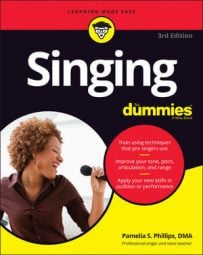The big question beginning singers ask is what to do with their hands. Well, what do you do with your hands as you speak? If your hands normally move when you speak, you may feel stiff if they remain frozen at your side during your song. Work the song as a monologue to discover what’s happening and how the character may react to the actions in the story.
Basically, you gesture when you react. For example, think about how you’d move in reaction to “Whoa! Don’t bring that spider any closer to me!” Or how would your hands gesture if you were saying, “I wanted to buy that doll, but the woman snatched it out of my hand” or “Here I am!” or “When are you going to clean up this incredibly messy room?”
If you recognize the same kind of opportunities in a song, you feel more like yourself gesturing with your hands than trying to plan something interesting to do during your song.
You may have noticed that when you gestured and said the phrases, your arms moved to gesture and then dropped. That motion is too abrupt when singing. You want to gesture and then release the gesture and move your arms and hands back down.
On the other hand, sometimes people go too far in gesturing by holding the gesture for a long time. You may look frozen as if you aren’t sure how to put your hands down.
The following exercise gets your hands in the right place for gesturing:
Put your hands by your side.
With your thumbs leading the way, move your hands up toward each other and then out in a big arc, with your elbows away from your body and your palms up and open.
Draw the Chanel logo — two back-to-back Cs, )( — in the air.
Start with your hands at your side and trace your hands from the bottom right hand of each C until your hands are out to the side of your body, with your hands about as high as your shoulders. To make the gesture look natural, you want distance between your elbows and the sides of your body.
Gestures can vary widely, but this is the most basic shape of a gesture. As you practice this movement, you’ll be able to do it faster and vary it slightly by using just one arm or by moving your arms higher for those times you need a big emphasis for your text.
Avoid these gesturing pitfalls:
Pantomiming: Pantomimic gestures only mime the text. For example, if you plan specific movements without thinking about why they help your story, such as lifting your hand to the sky when you say the words “Moon and stars,” or placing your hand on your chest when you say “heart,” you’re not doing your job as an actor.
What roles do those two elements play in your story? Your audience knows exactly where to find the moon and stars — give them something more. Pantomime may work if you’re creating a comic character, and pantomime is one way to play the character. However, serious songs work best when the gestures come from what you’re saying and thinking about the song, not from pantomime.
Choreographed moves: If your song is fun and spunky, allow your joy of singing the song to reflect through your story, not through choreography. You don’t need to plan any movements before you do your work on the text of your song. You want the gesture to feel organic, as if you’re experiencing it for the first time every time you sing the song.
If you’ve chosen a dance number for your song, you can assume that some movement is in order. Singing while dancing requires a great deal of stamina. Plan where to breathe in the song so you can practice your breath control.

